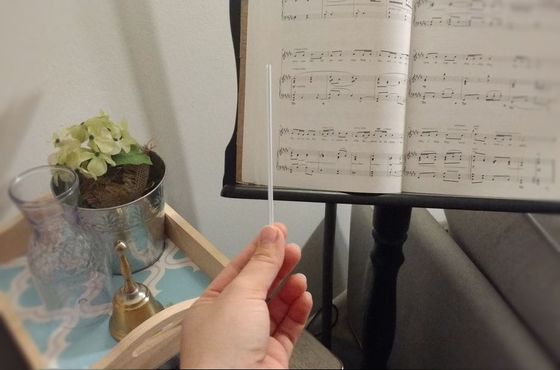|
I mentioned these in an earlier blog post about auditioning, but coffee stirrers are an amazing vocal tool. You need one that's basically a little straw, and the single tube (rather than the red double-tube kind) work best. Using one of these in your singing practice can help improve your legato, increase vocal stamina, and keep things quiet if you don't want to disturb anyone. But today I'm going to mostly talk about how it can help you improve your vocal range and avoid injury. First, you should understand a little bit about how vocal sound is produced. In your throat is a little box made out of cartilage called a larynx. This houses your vocal folds which are also surrounded by small connective ligaments and muscles. When you send air through these folds the rapid air flow decreases the pressure between the two folds and draws them together (Bernoilli's principle. The same thing that makes airplanes fly. Interesting, huh?). When the vocal folds are drawn together, they vibrate and create a buzz sound; these sound waves bounce around in your throat and mouth and when they make their way out--ta-da!--you've vocalized. So here's the thing; rather than simply allowing the fast flowing air to draw the vocal folds together, you can use the small muscles in/around the larynx to manually manipulate the vocal folds. You can actually "slap" theses folds together. Think about the last time you were yelling, especially in a crowd, maybe at a sports event or concert. Did your throat feel sore? Did speaking the next day hurt or feel uncomfortable? You were probably slapping your vocal folds together. It's very easy to resort to this sort of "slapping" technique when attempting to sing loudly. Most precocious young singers will resort to this to some extent. What's the problem with this? Well, besides the fact that the sound quality will always be at least a little forced, you're actually in danger of permanently damaging your delicate little vocal folds. Slapping them together can create a sort of blister and callous on your vocal chords (called polyps and nodules). Remember what I said about precocious young singers? Julie Andrews was pushed into serious vocal training very early and she didn't avoid the slapping/straining stumbling-block. She developed vocal nodules; the surgery to removed the nodules didn't go well and permanently damaged her vocal folds. Now, back to the straw. The straw can help you avoid vocal damage AND improve your vocal range, for the same reason: It helps you to create a constant, reliable air flow. If you look at my little diagram below, I've tried to visually represent the inverse relationship between breath and muscular activity in creating buzz tone. If your breath is 10 and your muscular activity is 0, you're just exhaling. If your muscular involvement is at a 10 and your breath flow is 0, you feel like you're choking. Actual sound production is somewhere in the middle where both air flow and muscles are involved. If you have a tight, pinched, or strident sound and have trouble singing in your upper range, you are likely too high on the muscular scale and too low on the breath scale. Vice versa, if your sound is breathy and weak, the air flow is probably too free, not fast enough, and your muscular activity too low or unengaged.  What does the straw do? It basically ensures the balance between the two, and is especially good for those who sing with too much tension on high notes (this is why it can instantly "increase" your range; It really just overrides your bad muscular habits so you can access your potential singing range). By singing through the straw you've created an external monitoring system for air pressure and constant airflow.
Here's how to do it:
Don't be afraid to really push your upper register, just make sure that the airflow never decreases. If you feel the airflow drop or skip you know you've reached a problem area. You have poor muscular habits in this range and you need to really work with the straw to overcome them. Slides and sighs are great for this. Singing with the straw is a great way to sing through your actual repertoire as well. It gives you an opportunity to sing through in a very non-stressful (for your larynx) way. You won't have any bad diction habits that are messing with your placement or adding tension. When you're singing through repertoire you can alternate phrases with the straw and singing on "sha" or something. Now is a really good time to learn to "feel' singing rather than listening to your own singing. Obviously the sound is going to be different because you're singing through the straw. But it should also feel different. Ask yourself how. How does this feel different? And how can I reproduce this feeling when I'm singing without the straw? Because that's the goal. Just practicing with the straw will train new muscle memory. But this exercise will be much more effective and work more quickly if you take the time to analyze it. Have fun practicing this week!
1 Comment
12/16/2018 11:49:32 am
I tried this and found it temporarily gave me morning voice. Now with a straw i can have morning voice all day! Relaxed clear and rsonant . i can use the lower range without even thinking. Just part of the landscape. I'm not a singer but this is fun anyway. Retired too much time on my hands no doubt. What ever gordy
Reply
Your comment will be posted after it is approved.
Leave a Reply. |
AuthorSinger, writer, mother, yogi, wife and chocolate enthusiast. Archives
January 2022
Categories |


 RSS Feed
RSS Feed